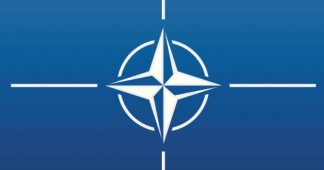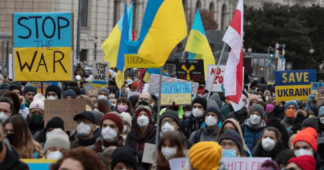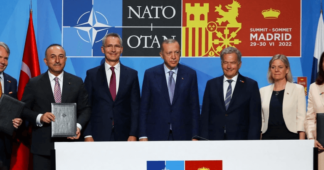By Jukka Pietiläinen
4 Jul 22
Jukka Pietiläinen analyses the left positions on Sweden´s and Finland´s NATO membership. Both countries intend to join NATO, however, perspectives and opinions on this issue are divided.
After the Russian attack on Ukraine began, both Finland and Sweden decided to apply for NATO membership. Both countries had been rather opposed to joining, despite working in close cooperation with NATO for decades. In the case of the left, the change in Finland was more radical. Finland’s main radical left party, the Left Alliance – which participates in the centre-left-green government – is divided on the issue of NATO membership. In May, of the Left Alliance’s 16 MPs, nine voted in favour of joining NATO, while six voted against (one was absent). In Sweden, however, the negative attitude towards NATO has continued to prevail in the Left Party.
Also in May, a joint meeting of the party council and parliamentary group of the Left Alliance decided that Finland applying for NATO is no longer a reason to leave the government, with a clear majority (52 votes in favour to 10 votes against, with one blank vote). When the government was formed in 2019, the no-NATO position was one of the key conditions for the Left Alliance to participate, even if the party accepted, as part of the Government Coalition Agreement, the NATO-option, i.e., the possibility to apply for membership if deemed necessary.
Finnish Left Alliance turning to NATO
The war in Ukraine changed positions on security in Finland, where the threat of war was previously considered very unlikely. According to opinion polls, long-term support of NATO membership has never exceeded 30% and has mostly been between 22–25%. In 2020, as many as 86% of Left Alliance voters opposed Finland’s NATO membership, however, in autumn 2021 this figure had fallen to 67%.
After the war began, opinions on NATO changed radically. Throughout spring 2022, support for NATO membership grew from 50% at the end of February to 75% in May and June. Among Left Alliance voters, support for NATO membership rose from around 40% in March to at least 47% (depending on the poll) in May. In the same month, 69% of Left Alliance voters saw military cooperation with NATO as very or rather positive. No less than 97% of the left party’s electorate viewed military cooperation with the EU in a positive light.
Although this change of opinions occurred rapidly, support for NATO membership is lower than expected. In an opinion poll conducted in January 2022, almost half (49%) of Left Alliance voters agreed (fully or partially) that if Russia started an open war against Ukraine, they would accept Finland applying for NATO membership. This figure was only slightly lower than the average for the whole population (60%).
The Left Alliance MPs who voted in favour of accession were in general younger than those who opposed, with no other division based on gender, region, or other factors. The party leadership largely accepted NATO membership and leading MPs voted for it.
As the Left Alliance MPs announced their decision in favour of NATO, in general they reported that the decision had been difficult and that NATO membership, while not ideal, was a necessary step in a changed security environment. The main pro-NATO argument has been that Finland has to choose the lesser of two bad options.
As Hanna Sarkkinen, Minister of Social Affairs and Health, stated: “I would like to think that a different world is possible, but solutions have to be made in the real world and those solutions are not always ideal.” Former party Vice-Chair Jussi Saramo called the positive vote for NATO membership “political realism”.
On 12 June, the Left Alliance Party Congress decided to change its NATO position by accepting a new programme of goals for 2022–2025. According to approved wording, the party accepts NATO membership as a reality and states that it will decrease security threats to Finland. The opposite proposal, which got 25% of votes, stated that Finland should remain neutral and not join any military alliance, and that NATO membership will not increase Finland’s security.
According to party sources, a small number of party members have announced that they will leave the party because of its NATO-position. For approximately half of them, this is because the former anti-NATO position has been changed and for the other half because they would like to see a more positive attitude towards NATO membership.
In Finland, all large and medium-sized parties have accepted NATO membership, while only small extreme right parties and the Finnish Communist Party remain opposed. The Finnish Communist Party also opposes exporting arms to Ukraine.
Swedish Left Party holds on to its position
For the Swedish Left Party (Vänsterpartiet), the Ukraine war has caused an internal division as well. Even though the party is no longer opposing exports of arms to Ukraine, both the Left Party and the majority of its voters have not changed their position on NATO. However, the Left Party’s support has dropped from 10% to 8% since the war in Ukraine began.
Traditionally, Swedish public opinion has also been rather negative towards NATO, although to a slightly lesser extent than in Finland. Support for NATO membership has increased to 30–35%, while the share of opponents fell to one third in 2018. Among Left Party voters, support for NATO membership was between 6–12% from 2005 to 2019.
Furthermore, the change has been less dramatic than in Finland. In May 2022, around 50–60% of Swedes supported NATO membership. Among Left Party voters, support for NATO membership was only 13%. It is therefore not surprising that the negative attitude has remained and that Left Party states that the NATO membership should be decided by referendum.
In Sweden, the Russian threat is not perceived as strongly as in Finland, and the tradition of neutrality is stronger. Moreover, the Swedish Left Party is also more critical towards the European Union and has not participated in government nor needed to adapt to political consensus.
Rather marginal groups of the Swedish Left even criticise the Left Party’s position on supporting arms exports to Ukraine, and the Swedish Left Party has not taken part in some peace demonstrations attended by the non-parliamentary left.
Conclusion
The different positions of the Finnish and Swedish left parties are based on the opinions of their members and voters – mostly negative in Sweden, divided but mostly positive in Finland. They also reveal the different political realities of these parties. The Finnish Left Alliance regularly participates in the coalition government, while the Swedish Left Party only reluctantly supports the minority government from the opposition. Moreover, consensus on foreign and security policy is traditionally higher in Finland.
We remind our readers that publication of articles on our site does not mean that we agree with what is written. Our policy is to publish anything which we consider of interest, so as to assist our readers in forming their opinions. Sometimes we even publish articles with which we totally disagree, since we believe it is important for our readers to be informed on as wide a spectrum of views as possible.











